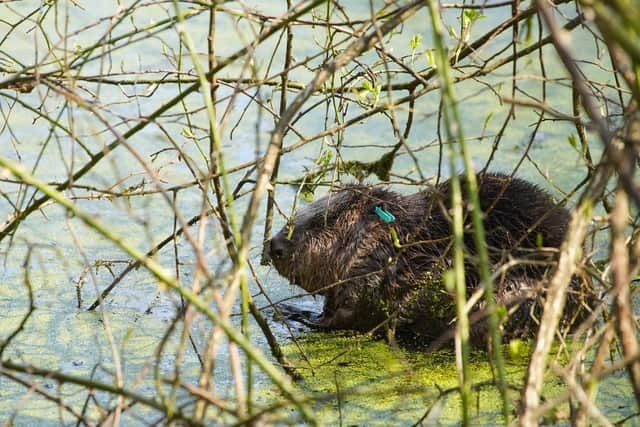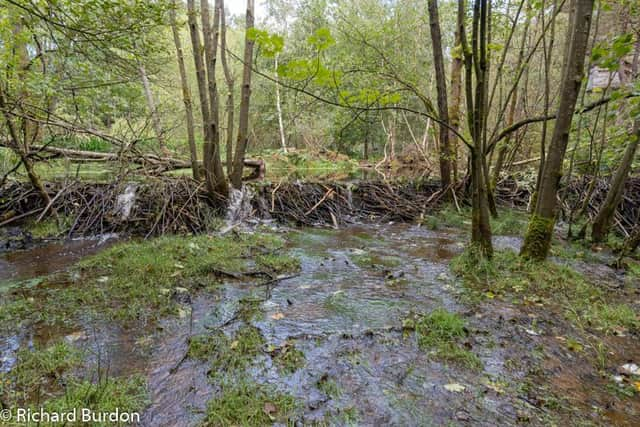Young beaver from Yorkshire reintroduction project at Cropton Forest to be relocated to Norfolk
Two breeding beavers were moved from a Scottish reintroduction programme in 2019 and rehomed in a specially built enclosure in Cropton Forest, near Pickering in the North York Moors, under the supervision of Forestry England ecologists.
The project was a major success, with the pair having several litters of kits and the family completely transforming the landscape around the ponds and beck in their enclosure as part of a trial to monitor their impact on natural flood management.
Advertisement
Hide AdAdvertisement
Hide AdHowever, though the enclosure is large enough for an extended family unit, to introduce genetic diversity and allow the kits to find mates of their own, one of the female offspring born in the first year of the trial is now being relocated to a similar scheme in Norfolk.


The three-year-old has been paired with a Scottish male in the hope that they will establish a beaver colony at Sculthorpe Moor Nature Reserve.
The original pair released in Cropton Forest in 2019 have bred every year since their arrival, and have six kits still remaining with them, with more expected to be born this summer.
The group have built a dam that is two metres high and 100 metres wide, raising upstream water levels, and have constructed a lodge. Data has supported the theory that their activities have 'slowed the flow' of rainwater and reduced flooding further down the valley, and other species such as frogs, toads and kingfishers have increased in number due to the beavers opening up the area around the ponds.
Advertisement
Hide AdAdvertisement
Hide AdForestry England ecologist Cath Bashforth said: “It was a proud moment seeing the first Cropton beaver move on and start her own territory many miles away from where she was born, and though I do admit to pang of sadness when she left, it’s a real sign of success for this enclosed reintroduction trial.


“It will be fascinating to see how she puts the dam building skills she’s learnt so well from her parents into practice at her new home, helping to create in Norfolk some of the incredible biodiversity benefits we’re experiencing here. The numbers and types of wildlife species we’re now seeing in such a short space of time is amazing, from the blue flash of kingfishers, the still silhouette of a hunting heron over the water and the wonderful sight of the dusk flight of the noctule bats now using bat boxes put up for them 30 years ago.
Ross Snipp from Flamingo Land Zoo, who cared for the beaver and provided health checks before the onward journey, added: “Flamingo Land Zoo is proud to have once again supported the team at Forestry England by providing accommodation for the beavers during their health checks and quarantine period. The zookeepers have welcomed the opportunity to be
involved in this project and to use their expertise caring for such amazing animals. Our keepers built a temporary lodge for the beavers in our quarantine building and undertook daily feeding as well as remote monitoring using camera traps. Our work with the beavers is part of our ongoing commitment to native species conservation and is a great example of the role that zoos play in species conservation.”
Advertisement
Hide AdAdvertisement
Hide AdForestry England is working with researchers from the universities of Leeds, Hull, Teesside and Exeter and more than 40 volunteers to monitor the wildlife and ecosystem impacts of
the trial. Monitoring is giving detailed data on the water quality and flow rates in the wetland area upstream and downstream from the beavers’ dams, and aerial imaging is being used to track changes to the site which the beavers have created. Camera-trap video is building a clear picture of the beavers’ behaviour, and dedicated volunteers are doing regular on the ground biological monitoring, putting in more than 1,000 hours to the trial so far.
Forestry England will keep monitoring the Cropton Forest beavers over the remaining two years of the trial, assessing the impact they continue to have on biodiversity and flood
management. Other juveniles may be relocated if the right homes are found for them.
The beavers of Cropton Forest
Advertisement
Hide AdAdvertisement
Hide AdThe enclosure site is owned by Forestry England and has a fascinating history of its own - the ponds were once pleasure boating lakes for the Reckitt family, a Hull manfacturing dynasty who owned the nearby Keldy Castle estate. Their land was requisitioned for military training during World War Two and the house, which they had used as a shooting lodge, fell into disrepair. By 1956, it had been demolished. Signs of their past presence, including a rotten birdwatching hide in the woods, can still be seen.
The area was then used as a conifer plantation, but commercial forestry has now ended and the site devoted to beaver welfare.
Beavers vanished from Yorkshire in the 16th century, hunted to extinction by the early 1500s for their fur and a secretion from their glands called castoreum, which was used to make perfumes and medicines. They suffered the same fate in Europe, although small pockets survived and their continental populations have recovered. The beavers reintroduced to Scotland came from Norway.
They were soft prey for hunters who could easily spot an occupied beaver lodge by the steam rising from the top as they slept inside. Ironically, beavers have few natural predators - centuries ago, they were eaten by wolf, bear and lynx, but in today’s Britain they would be rarely targeted, although otters have been known to take a kit.
Comment Guidelines
National World encourages reader discussion on our stories. User feedback, insights and back-and-forth exchanges add a rich layer of context to reporting. Please review our Community Guidelines before commenting.

